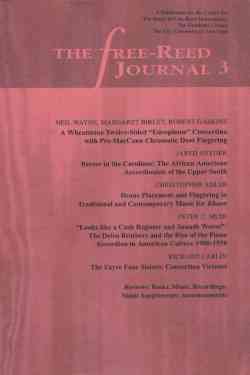
Five Articles:
Plus: Reviews of books, music & recordings, music supplements, announcementsNeil Wayne, Margaret Birley, Robert Gaskins: A Wheatstone Twelve-Sided "Edeophone" Concertina with Pre-MacCann Chromatic Duet Fingering
Jared Snyder: Breeze in the Carolinas: The African American Accordionists of the Upper South
Christopher Adler: Drone Placement and Fingering in Traditional and Contemporary Music for Khaen
Peter C. Muir: "Looks Like a Cash Register and Sounds Worse": The Deiro Brothers and the Rise of the Piano Accordion in American Culture 1908-1930
Richard Carlin: The Fayre Four Sisters: Concertina Virtuosi
Published: 2001
Review date: May 2001
Paper cover
6 x 9 inches
122 pages
Published by Pendragon Press http://www.pendragonpress.com
PO Box 190
Hillsdale, NY 12529
Fax: 518-325-6102
email: penpress@-aconic.net
Review by Henry Doktorski:
American Accordionists should run to their telephones and order this issue of The Free-Reed Journal before it goes out of print. You will get a special thrill not only from the entire contents of the issue, but especially from the two articles about the accordion in America: Jared Snyder's article about African American accordionists in the 19th and early 20th centuries and Peter Muir's article about Guido and Pietro Deiro.Of course, the other three articles about 1. a curious 1938 Wheatstone 12-sided concertina, 2. the khaen and 3. the Fayre Four sisters, the British concertina hit group of the 1920s and 1930s were excellent also. But, being primarily an accordionist, I was STRUCK by the two accordion articles.
Jared Snyder, a familiar name to Free-Reed Journal readers from his article in volume one about the accordion in Africa, has produced a fascinating account of the accordion in the southeastern United States as played by African slaves and their descendants. This is a part of accordion history of which I was completely ignorant. I was enthralled by the illustrations: 1. a photograph of a slave from the household of Confederate General Robert E. Lee playing a German button-accordion, 2. a painting by Samuel Hollyer and John Rogers titled "Pic Nic on the Fourth of July" dated c. 1864 which shows a child at play while her black nursemaid entertains her on a French accordeon, 3. a photo titled "Cooks at Fort Beaufort, S.C., 1862" which shows two men seated on the steps of the barracks, one white and one black, the latter holding his French accordion in his hands, as well as several other photographs from the 1890s and 1930s. (Unfortunately the quality of the printing of some of the photographs in the journal was so poor I could not see any details to speak of.)
Snyder traces the development of the African-American accordion tradition from the black face minstrel shows of the 1840s through the civil war and beyond. Did you know that the accordion was an important part of the civil-war soldiers life? Synder quoted a correspondent who described his experiences in the camps of the army of the north: "Musicians were a great feature of winter camp-life. . . Violins, flutes, banjos, and the sonorous accordeon were to be found in every regiment."
Finally at the end of his 42-page article, Snyder states why the diatonic accordion died out among black musicians of the southeast: it could not produce the blues scale, which became a major component of popular dance music by the 1920s. Fascinating article.
Another great article is Peter Muir's "Looks Like a Cash Register and Sounds Worse": The Deiro Brothers and the Rise of the Piano Accordion in American Culture 1908-1930. Muir describes the rise of the golden age of the accordion in America in a gripping 24-page article about Guido and Pietro Deiro, the two brothers who dominated the piano accordion industry by their vaudeville performances and recordings from 1908 to the Great Depression.
Muir quotes contemporary newspaper reviews which marveled at the two brothers and their instruments: "Signor [Guido] Deiro is playing what he is pleased to call a piano accordeon. . . It looks like a huge, old-fashioned glorified accordeon. . . In the hands of the master it is a wonderful instrument capable of playing the most involved symphonies and at the same time the simplest of harmonies." (Pittsburgh Post, May 11, 1911)
Yet not all the reviewers were agog with praise. The title of Muir's article comes from a review which appeared in the Minneapolis Journal of December 16, 1912 which stated, "A fearful instrument that looks like a cash register, and sounds worse, produces gasps of pleasure at the Orpheum this week. It is called a piano accordion and its behavior is shameless. . . Applause follows each atrocity. [Guido] Deiro is a great success."
Truly a fascinating account of the early careers of the Deiro brothers. Allan Atlas, editor & founder of The Free-Reed Journal, has done it again. My congratulations go to him and all the contributors to this issue.
| About The Free-Reed Review |
| Invitation to Contributors / Submission Guidelines |
| Back to The Free-Reed Review Contents
Page |
| Back
to The Classical Free-Reed, Inc. Home Page |